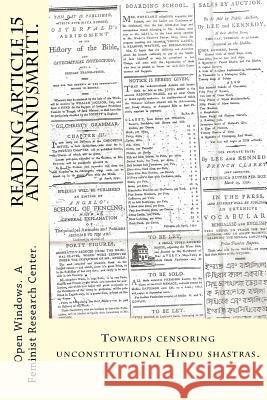Reading Article 15 and Manusmriti.: Towards censoring unconstitutional Hindu shastras. » książka
Reading Article 15 and Manusmriti.: Towards censoring unconstitutional Hindu shastras.
ISBN-13: 9789384281137 / Angielski / Miękka / 2016 / 64 str.
Reading Article 15 and Manusmriti.: Towards censoring unconstitutional Hindu shastras.
ISBN-13: 9789384281137 / Angielski / Miękka / 2016 / 64 str.
(netto: 20,85 VAT: 5%)
Najniższa cena z 30 dni: 22,01
ok. 16-18 dni roboczych
Bez gwarancji dostawy przed świętami
Darmowa dostawa!
It is one thing when religious institutions talk about God and the Supreme Being and the Hindu shastras, and it is also another thing when these institutions also throw in a lot of theology which is outright misogynous and sexist and caste-ist, and thereby exclude half the population of India. Are religious institutions participants in propounding sexist and caste-ist theology which affects how people engage in their every-day lives? Do these institutions therefore, violate the Fundamental Rights that are granted to all the citizens of India by the Constitution? If caste-ist and sex-ist discourse is allowed to function in the public realm, it tantamounts to being unconstitutional and comprises a violation of one of the Fundamental Rights that has been granted in India, namely, Article15 of the Constitution of India and is the Right to Equality. 15. Prohibition of discrimination on grounds of religion, race, caste, sex or place of birth.- (1) The State shall not discriminate against any citizen on grounds only of religion, race, caste, sex, place of birth or any of them. The larger question which we should all strive towards is: why should the Hindu shastras be seen as comprising, in its totality, "revealed knowledge" when large chunks of it refer to temporal behavior that is based on one's gender or caste (the most oft-cited being Manusmriti's Varnashrama). Why are they cited as being infallible when often these texts propound extremely sexist and caste-ist views? The yet unresolved conundrum, thus is: how does the Indian state (which is also a signatory to CEDAW) allow these texts to be a part of public discourse as they are often, and mostly, quite unconstitutional? The rampant sexist and caste-ist discourse that is intrinsic to our Hindu shastras is overt and unapologetic. How we, that is, women - eat, breathe, dress and conduct ourselves and the kinds of labor that we are allowed to perform - are codified and seen as intrinsic to the Hindu shastras. The realm of religion, indeed, is the privilege of men. And indeed, it would not be salacious to argue that self-identifying Brahmin men and those who function in the religious institutions and are the so-called custodians of Hindu dharma are mostly myopic; they are unable to distinguish between what constitutes "revealed knowledge" about Existence and Brahman and Creation, and temporal gender-caste based social modes of being. What prevents the government of India (which is also a signatory to CEDAW) from slapping legal cases against these religious institutions as they propound unconstitutional rhetoric that, in all respects, violates our Fundamental Rights that are embedded within the Indian Constitution? The larger question, though, is: can we ever take it for a given that what we know, in a definitive manner, as being central to the Hindu shastras can be construed as being infallible? - for all we know - these texts might have been amended and changes made as they were handed down generations. In the preface to his version of Manavadharma, Sir William Jones wrote about the textual variations that existed and how he collated different versions that were available in manuscript form to arrive at his final text. We can arrive at the obvious conclusion that William Jones consulted many textual variations of the Manusmriti, and if so, the implication is that there was no single authoritative text. If these texts that constitute our Hindu shastras are unreliable with numerous variants existing simultaneously, then it stands to reason that there is no authentic version that we can refer to as being the original. Who is to tell as to which part comprised "revealed knowledge" and which sections were subsequent add-ons?











